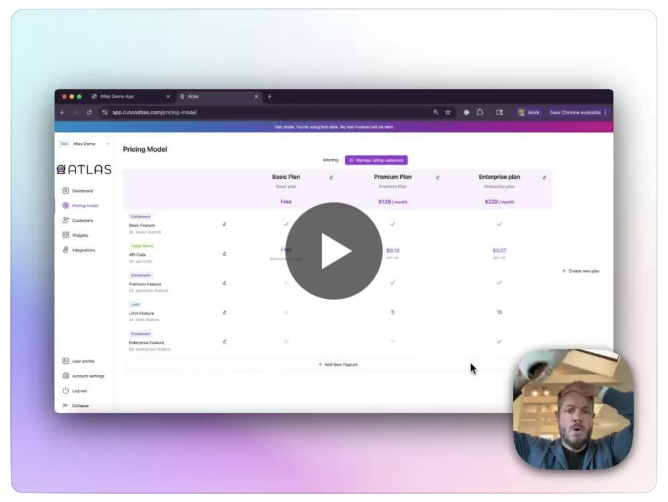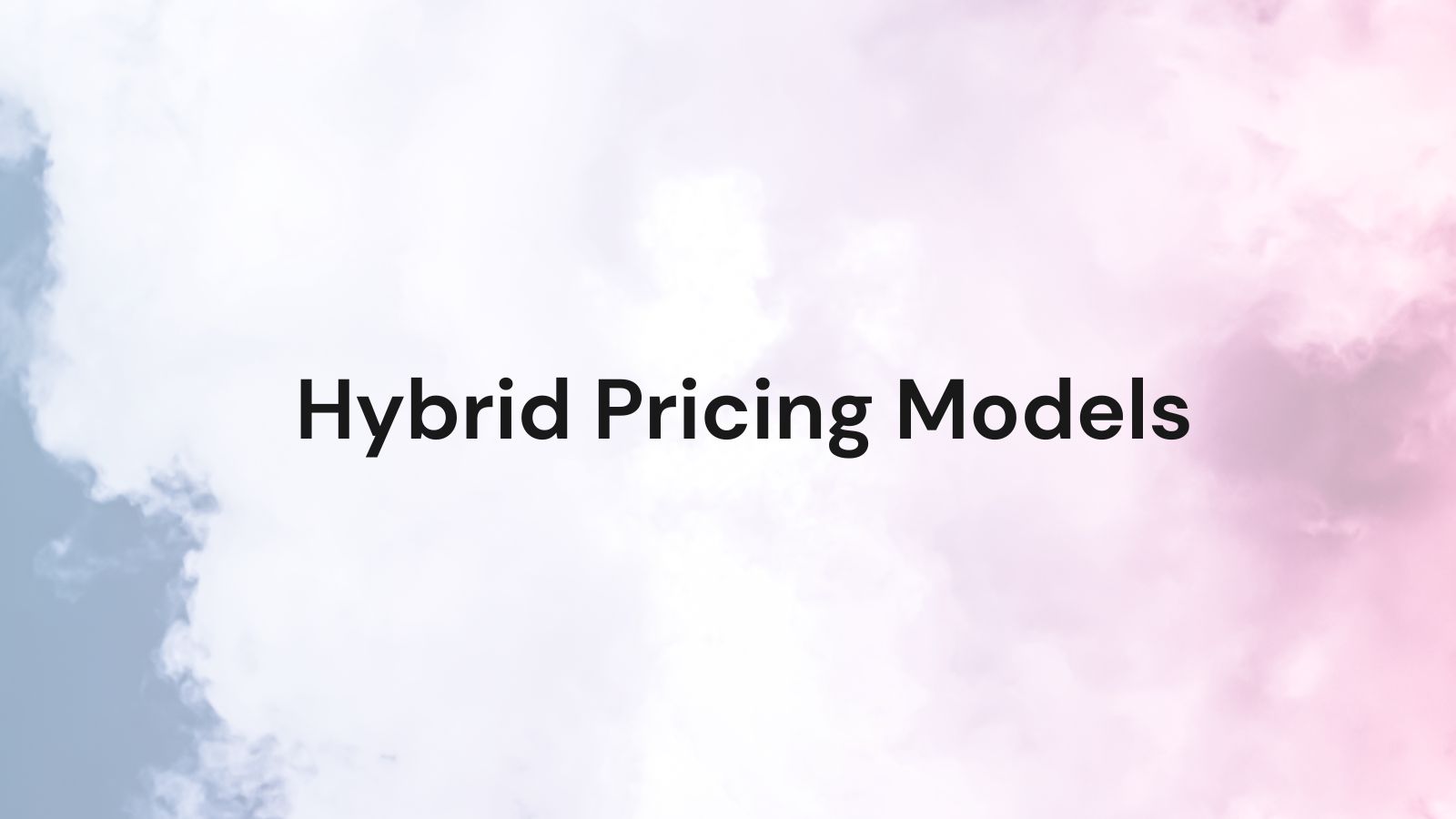Why Usage-Based Pricing Is a Great Model for AI-Native Companies
.png)
What is Usage-Based Pricing?
Usage-based pricing is a billing model where customers pay based on their actual consumption of a product or service, rather than a flat subscription fee. Also known as pay-as-you-go, consumption-based pricing, or metered billing, this model charges customers proportionally to how much they use your product.
Instead of paying a fixed monthly fee for unlimited access, customers are billed for specific metrics like API calls made, tokens processed, compute hours used, data stored, or transactions completed. This creates a direct correlation between the value customers receive and what they pay.
How Usage-Based Pricing Works
The mechanics of usage-based pricing are straightforward:
Identify your usage metric. Choose what you'll measure—API requests, processing time, data volume, or another consumption indicator that reflects the value your product delivers.
Track consumption in real-time. Your system monitors and records each customer's usage continuously throughout the billing period.
Calculate charges dynamically. At the end of each billing cycle, you multiply the usage by your unit price to generate the invoice amount.
Provide transparency. Customers can see their current usage and projected costs, allowing them to make informed decisions about their consumption.
Many companies implement tiered usage-based pricing, where unit costs decrease as volume increases, rewarding larger customers while maintaining accessibility for smaller users.
Why Usage-Based Pricing is Ideal for AI-Native Companies
AI-native companies face unique characteristics that make usage-based pricing not just advantageous, but often essential for sustainable growth.
Variable Cost Structure Matches Variable Revenue
AI products typically have significant variable costs. Every API call requires compute resources, model inference costs money, and data processing scales with usage. When your costs scale with customer usage, your revenue should too. Usage-based pricing creates natural alignment between what you spend to deliver value and what you earn.
Traditional subscription pricing creates misalignment. A customer using 10x more resources than another pays the same monthly fee, squeezing your margins on heavy users while potentially overcharging light users who might churn.
Eliminates Adoption Friction
AI products often require experimentation before customers understand their full value. Usage-based pricing removes the psychological barrier of committing to a substantial monthly fee before seeing results.
Developers can start with a few API calls, data scientists can test your model on sample data, and product teams can run small pilots—all without budget approval for a full subscription. This frictionless entry point accelerates adoption and expands your top-of-funnel dramatically.
Grows Naturally With Customer Success
The best pricing model rewards you when customers succeed. With usage-based pricing, as customers derive more value from your AI product, they naturally use it more, and your revenue grows automatically.
A customer starting with 1,000 API calls per month might scale to 100,000 as they roll out your solution across their organization. You capture that growth without renegotiating contracts or forcing upgrades to higher tiers. The pricing model becomes a growth engine rather than a constraint.
Reflects the Reality of AI Economics
AI workloads are inherently variable and unpredictable. A customer might have irregular spikes in processing needs, seasonal variations in usage, or experimentation phases followed by production deployment.
Usage-based pricing accommodates this reality. Customers aren't locked into paying for capacity they don't need during slow periods, and you're compensated fairly during high-usage phases. This flexibility makes your offering more attractive and economically rational.
Competitive Alignment With Market Leaders
The most successful AI-native companies—OpenAI, Anthropic, Google AI, AWS AI services—use usage-based pricing as their primary model. This isn't coincidental. They've discovered that this model works best for AI products.
Adopting usage-based pricing positions you alongside market leaders and meets customer expectations. Developers and technical buyers in the AI space expect to pay for what they use, making your pricing immediately familiar and acceptable.

Common Usage Metrics for AI Products
Choosing the right usage metric is critical for a successful usage-based pricing model:
Token-based pricing charges per input and output tokens processed, ideal for large language models and text generation APIs.
API call pricing bills per request made to your service, suitable for prediction APIs, classification models, or any inference endpoint.
Compute time pricing charges for the actual processing time or GPU hours consumed, appropriate for resource-intensive AI workloads.
Data volume pricing bills based on the amount of data processed, stored, or analyzed, common for data analytics and machine learning platforms.
Transaction pricing charges per prediction, classification, or output generated, regardless of the underlying resource consumption.
The best metric is one that customers can understand, predict, and control, while accurately reflecting your cost structure and the value delivered.
Implementing Usage-Based Pricing: The Technical Challenge
While usage-based pricing offers significant advantages, implementation presents technical complexity:
You need infrastructure to track usage accurately in real-time across potentially millions of events. Your system must handle metering reliably, aggregate usage data efficiently, and calculate bills correctly even with complex pricing tiers or multiple metrics.
You need to provide customers with real-time visibility into their consumption and projected costs. This requires building usage dashboards, setting up alerting systems, and creating reporting infrastructure.
You need to handle billing edge cases: proration, credits, refunds, failed payments, and usage disputes. Your billing system must integrate with payment processors, accounting software, and tax calculation services.
Building this infrastructure from scratch can take months of engineering time—time better spent developing your core AI product.
Launch Usage-Based Pricing in Minutes With Atlas

Atlas makes implementing usage-based pricing effortless for AI-native companies. Instead of building complex metering and billing infrastructure, you can launch consumption-based pricing in minutes.
Atlas provides everything you need out of the box:
Real-time usage tracking that accurately meters consumption across any metric you choose, with reliable event ingestion that handles millions of usage events.
Flexible pricing configuration that supports simple per-unit pricing, volume tiers, graduated pricing, and complex multi-metric models without writing code.
Customer usage dashboards that give your users complete visibility into their consumption, current charges, and projected costs, reducing billing surprises and support inquiries.
Automated billing and invoicing that calculates charges accurately, generates invoices automatically, and integrates with your payment processing and accounting systems.
Developer-friendly APIs that make it simple to report usage from your application, query consumption data, and manage customer billing programmatically.
With Atlas, you can focus on building exceptional AI products while we handle the complexity of usage-based pricing and billing. What would take months to build takes minutes to deploy.
Best Practices for Usage-Based Pricing
To maximize the effectiveness of your usage-based pricing model:
Start with clear unit economics. Understand your costs per unit of usage and price accordingly to maintain healthy margins across different usage patterns.
Provide usage visibility. Give customers real-time dashboards showing current consumption and estimated costs. Transparency builds trust and reduces billing disputes.
Set usage alerts. Let customers configure alerts when they approach certain spending thresholds, preventing bill shock and improving the customer experience.
Offer predictable options. Consider hybrid models with base fees plus usage charges, or committed use discounts for customers who want more predictable billing.
Implement rate limiting. Protect your infrastructure and customer budgets with optional usage caps that prevent runaway consumption.
Keep pricing simple. Resist the temptation to create overly complex pricing with too many metrics or tiers. Customers should be able to estimate their costs easily.
The Future of AI Pricing
Usage-based pricing isn't just a trend—it represents a fundamental shift in how software companies capture value. As AI becomes more embedded in business operations, customers increasingly expect to pay in proportion to consumption.
For AI-native companies, usage-based pricing offers the best alignment between costs, value delivered, and customer expectations. It removes adoption barriers, scales naturally with customer success, and positions you competitively in the market.
The companies that will win in the AI era are those that make their products accessible, valuable, and economically rational. Usage-based pricing is the model that achieves all three.
Ready to implement usage-based pricing for your AI product? Atlas makes it easy to launch consumption-based billing in minutes, not months. Get started in minutes.
Ready to Go From Idea to Revenue?
Atlas gives you everything you need, pricing strategy, checkout, billing, analytics, and more to start making money.



.png)
